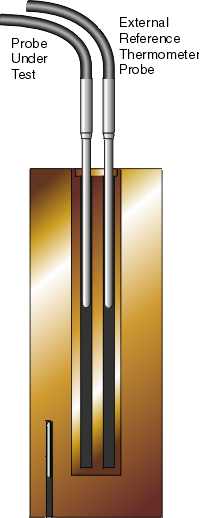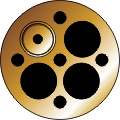- Other Fluke companies:
- Fluke
- Fluke Biomedical
- Fluke Networks
- Fluke Process Instruments
Selecting a Dry-Well (Dry-Block) Temperature Calibrator
If you have industrial temperature sensors such as RTDs, thermocouples, thermistors, bi-metal thermometers or liquid-in-glass thermometers to calibrate, you need a reliable heat source to verify accuracy.
A dry-well calibrator (dry-block calibrator) is a great combination of accuracy, portability and price for industrial calibration applications. Typical dry-well calibrators produce calibration accuracies of better than ±0.5°C over a range of –25°C up to 650°C. In addition, for comparison of sensors in a dry-well’s temperature block, hole-to-hole uniformity is typically ±0.05°C. These uncertainties are well matched to the typical uncertainties of industrial temperature sensors.
To select the appropriate dry-well for your industrial sensors you should consider:
- Temperature Range
- Accuracy and Stability
- Well Flexibility
- Portability
- Sensor Immersion
- Throughput
Have questions? Consult with a temperature calibration expert.
Temperature Range
The temperature limits of the dry-well must meet your minimum test requirements for the sensors being calibrated. The ideal calibration spans the entire usable range of the test sensor. However, extrapolating a non-critical temperature point may save time while not affecting the overall system uncertainty.
Even after a full-range calibration of your temperature sensor, it’s a good idea to check its accuracy in the precise range it is most often used. If you calibrate an RTD between 0°C and 100°C but are only monitoring room temperature, you may want to set your dry-well to 25°C and see how your calibrated sensor performs at its most important temperature.
Accuracy and Stability
The two most critical specs on a dry-well are accuracy and stability. Accuracy is how close the dry-well is to the programmed set-point. Stability is the temperature fluctuation of the instrument around the desired set-point over time. These two parameters add together to create the uncertainty of your calibration. If your dry-well does not meet your accuracy requirements and does not maintain a stable temperature, your probe could be reading a much different temperature than your display indicates.
A good rule of thumb is to make sure that your dry-well is at least twice as accurate as the sensors you are checking. Also, make sure to get a certificate from the manufacturer certifying that the accuracy is traceable to NIST. It shouldn’t cost extra for the certificate.
Here’s another tip. The dry-well should have at least the set-point resolution of the accuracy it claims or your target accuracy. For example, if you are calibrating an RTD to ±0.5°C at 100°C and your instrument only displays temperature to ±1°C, you obviously can’t claim better than 1°C for your calibration.
Well Flexibility
 When purchasing a dry-well, make certain that the probes you need to test will fit in the unit’s heated block. Most dry-wells use removable sleeves to size the main temperature well. This gives you the flexibility to calibrate a wider variety of probes with one instrument. The best accuracy comes from the holes that are drilled directly into the block because the contact between the sensor and the heated block is better. Using a removable sleeve can add additional uncertainty by introducing an air gap in the block.
When purchasing a dry-well, make certain that the probes you need to test will fit in the unit’s heated block. Most dry-wells use removable sleeves to size the main temperature well. This gives you the flexibility to calibrate a wider variety of probes with one instrument. The best accuracy comes from the holes that are drilled directly into the block because the contact between the sensor and the heated block is better. Using a removable sleeve can add additional uncertainty by introducing an air gap in the block.
Make sure that as you compare sensors in the same block they are both in the same mass of metal. The manufacturer should be able to recommend the best way to compensate for the error in removable sleeves. For comparison calibrations in a dry-well, Hart Scientific recommends a specially designed sleeve with multiple holes in the same sleeve. This eliminates most of the introduced error.
Portability
If you carry a lot of instruments to field sites, portability may be a concern. Size, weight and “carry-ability” are important factors to consider with many industrial applications. A dry-well should be designed for easy transport to the test site.
 One of the most significant developments in dry-well technology was the emergence of the handheld dry-well. This brought dry-well technology to a new level of practicality. You can now pack a dry-block calibrator into your tool kit, whereas before you had to put it on a cart to move it around.
One of the most significant developments in dry-well technology was the emergence of the handheld dry-well. This brought dry-well technology to a new level of practicality. You can now pack a dry-block calibrator into your tool kit, whereas before you had to put it on a cart to move it around.
Some of these handheld units can be battery powered for greater portability. What we used to call portable is now bulky and heavy. Make sure that your unit adds to your calibration power, not to your back problems.
Sensor Immersion
Sensor immersion depth is a recurring topic when considering a dry-well for calibration of temperature probes. Immersion can be the single largest contributor to error in dry-well calibrations. In the ideal world, all of our sensor assemblies would be the same size and depth. Unfortunately, this is not the ideal world.
 Immersing a 2-inch sensor assembly into a 6-inch well could yield an error up to 10°C. This is inherent in all dry-wells. In many cases, a bath is a better calibration medium, but not always practical. There are some techniques you can use to counter this error and bring a dry-well into a workable uncertainty level.
Immersing a 2-inch sensor assembly into a 6-inch well could yield an error up to 10°C. This is inherent in all dry-wells. In many cases, a bath is a better calibration medium, but not always practical. There are some techniques you can use to counter this error and bring a dry-well into a workable uncertainty level.
When calibrating a short-stem probe, always use a comparison technique. Do not compare the test reading to the dry-well display; it doesn’t give you the best results. It’s better to use a reference probe of similar size and diameter. The closer the sizes match, the more accurate the comparison. Size impacts the amount of heat lost to ambient through the probe stem.
Immerse the similarly sized probes, the reference and test probe, at exactly the same depth into the block in holes that have a similar fit and distance from the heating source of the unit. What you are trying to achieve is identical heat properties inside the block, ensuring that both sensors are sensing the same temperatures in the same way. Any deviation will cause further error.
Throughput

If you are like the rest of the world, trying to calibrate as many sensors as possible in a limited time period, get a block calibrator that allows you to insert more than one probe at a time. If your unit only has one calibration well, have the manufacturer drill several holes into the removable sleeve.
An additional consideration for increased throughput is automation. Make sure that you select a manufacturer that has truly automating calibration software for controlling the calibration of your probes. This can save you an enormous amount of time. Also, make sure the unit you select includes a PC link, like an RS-232 interface, so if you need to automate in the future to stay competitive, you can.
Dry-wells have become the most practical tools in industrial temperature calibration. Units are built now that fit in your hand. Some are battery-powered and even accurate enough to be used as lab standards. Microprocessor-based controllers can store set-points and ramping cycles and even interface to your PC. Each unit is unique in its ability to satisfy the requirements of specific calibration applications.
Select the dry-well that best fits your application and you will have years of successful calibrating. If you have specific application concerns, call the manufacturer. They should be able to help you select the unit that best fits all the considerations mentioned in this article.
Keep learning
Dry-Block Calibrators vs. Temperature Baths: Choosing the Right One for You - app note
Introduction to Dry Block Calibrators - video
Metrology Wells Versus Dry-Wells: Do Vertical Gradients Really Matter? - app note
Recommended products
Calibration reference probes & sensors
Get help
Need help choosing a product? Speak with a calibration equipment expert
- Home
- Products
- New Products
- Electrical Calibration
- RF Calibration
- Data Acquisition and Test Equipment
- Temperature Calibration
- Humidity Calibration
- Pressure Calibration
- Flow Calibration
- Process Calibration Tools
- Calibration Software
- Service and Support
- All Calibration Instruments
- Purchase Info
- News
- Training and Events
- Literature and Education
- Service and Support
- About Us

